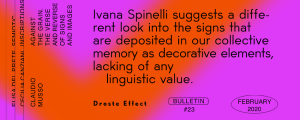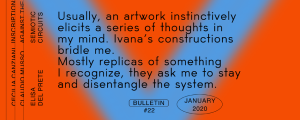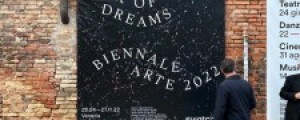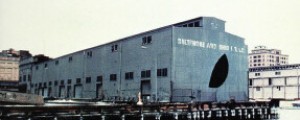Room to Live: Contemporary, conceptual, California
California/Los Angeles occupies a definite place in my experience and imagination, having traveled there frequently for over a decade. It is both a place and a space for art and the creative process; a contradictory place which accommodates both fierce individualism and idealized communalism; the harbinger of things and concepts both new and ephemeral; and, a synonym for those things artificial, superficial, public, performative, youthful, and impermanent. Many—Americans and non-Americans alike—equate California /Los Angeles with a particular type of American dream, whether of wealth, fame, property, or a rough idea of freedom. Regardless of perception or reality, it is a generally uncontested fact that though Los Angeles’ art “scene” is relatively young (say, as compared to New York’s), it has nonetheless expanded impressively in the decades after World War II. Whether they were fleeing the established circles and schools of New York and the east coast or drawn to that legendary light which in a previous generation had seduced filmmakers, American artists have found their slice of California in Los Angeles. From Ed Ruscha’s city blocks to Sam Francis’ interpretations of light to John Baldessari’s maps, there is the literal and metaphorical California to be found and expressed in highly conceptual forms. Los Angeles, after all, is one of the American centers of conceptual art, reflecting its history of and reputation for disestablishment and refusal to be bound.

Installation view of Room to Live, photo by Brian Forrest, © The Museum of Contemporary Art, Los Angeles
While Room to Live (at The Museum of Contemporary Art in Los Angeles) is officially a show to emphasize relatively-recent acquisitions, to explore “themes of place, architecture, life, growth, and inhabitation,” and to “celebrate the expanding and specific nature of MOCA’s collection,” it is also an interesting compendium of those snapshots and moments of California which change with every generation while still retaining its original promise of the Golden Land (as John Didion might suggest). For instance, there is work by Marnie Weber, who lives and works in Los Angeles and whose multi-media, multi-genre work speaks directly and indirectly to the surreal quality of the California landscape as well as to Hollywood’s film and performance culture. Giggle of Clowns (2009) is not only a good sample of her conceptual, surreal work, but also refers to A Western Song (2007), her woman-centric take on a classic California genre, the western. Indirectly, but no less powerfully, California is also represented in the show by William Leavitt, who is long associated with the emergence of conceptual art in Los Angeles in the 1960s and 70s. His paintings, tableaux, and works on paper capture a certain kind of regional feeling which may be described as the intervention of the suburban in both urban and rural landscapes. Vistas meet a studied yet effortless domesticity. Warp Engines (2009) honors the mid-century modern architectural style frequently associated with Los Angeles, but also refers to another classic Hollywood genre: science fiction.

Marnie Weber, Smuts the Clown from Giggle of Clowns, Room to Live, The Museum of Contemporary Art, Los Angeles

William Leavitt, Warp Engines, 2009, Mixed media installation with sound, Room to Live, The Museum of Contemporary Art, Los Angeles
The conceptual side is also strongly represented by many diverse artists including Ryan Trecartin and Lizzie Fitch, Nan Goldin, Bruce Naumann, and Samara Golden. The scope and scale—video montages, texts/sub-texts, photographs, and tableaux—recall the ambition and mordant humor of conceptual art. Arguably, some of these pieces, while not about California per se, puts one in that frame of mind, given the overall context and individual artist preoccupations. Nan Goldin, one of the first documenters of that fine line between private and public, reminds us that the desire for celebrity remains a regional and national preoccupation, in her moving and provocative early photographs. Like Marnie Weber, she also references the rock, punk and post-punk music scene of the 1970’s and 1980’s. Obsession and dependency, frequent Hollywood subjects, are also prominent in her work. Ryan Trecartin and Lizzie Fitch’s video piece, The Re’Search (Re’Search Wait’S) (2010), defies categorization, even as it unfurls images of young Hollywood and bourgeois aspirations: swimming pools, blasé manifestos, reality TV, and deliberately deconstructed sartorial style.

Nan Goldin, Self-Portrait in Blue Bathroom, London, 1980, Cibachrome print, Room to Live, The Museum of Contemporary Art, Los Angeles

Ryan Trecartin, Lizzie Fitch/ Ryan Trecartin, The Re’Search (Re’Search Wait’S) from B: Settings, 2010, Video, Room to Live, The Museum of Contemporary Art, Los Angeles
Typically, the MOCA exhibitions give the pieces plenty of room, including generous white space and boundary-defining corners and walls to invite contemplation, even when the scale of the work is colossal and dense (as in last summer’s Urs Fischer show). This time, however, the curators and exhibition designers have fully utilized the space, taking advantage of its height, breadth, and complexity; we are treated to the museum’s physical and curatorial scope. The exhibit’s organization, roughly, from the newest to oldest acquisitions, similarly speaks to MOCA’s focus on contemporary art, while slowly drawing us back toward those Modern pieces which were daring for their time. MOCA has also traditionally given plenty of room for women and non-white artists, and this exhibition is no exception, noted duly by many visitors. With Room to Live, the MOCA of Los Angeles asserts its well-deserved pride of place in terms of contemporary and conceptual art, and just as important, provides a large slice of that California which is elusive and mutable.

Bruce Nauman, Make Me Take Me, 1993, Pencil drawing on paper, The Museum of Contemporary Art, Los Angeles
Room to Live: Recent Acquisitions and Works from the Collection was organized by Bennett Simpson at The Museum of Contemporary Art in Los Angeles and runs through 13 January 2014.
by Catherine Nueva España
in Focus on the American West
Nov 25, 2013























[…] Droste Effect Magazine Room to Live: Contemporary, Conceptual, California Luc Tuymans at the Menil Collection Sam Francis at Pasadena Museum of California […]